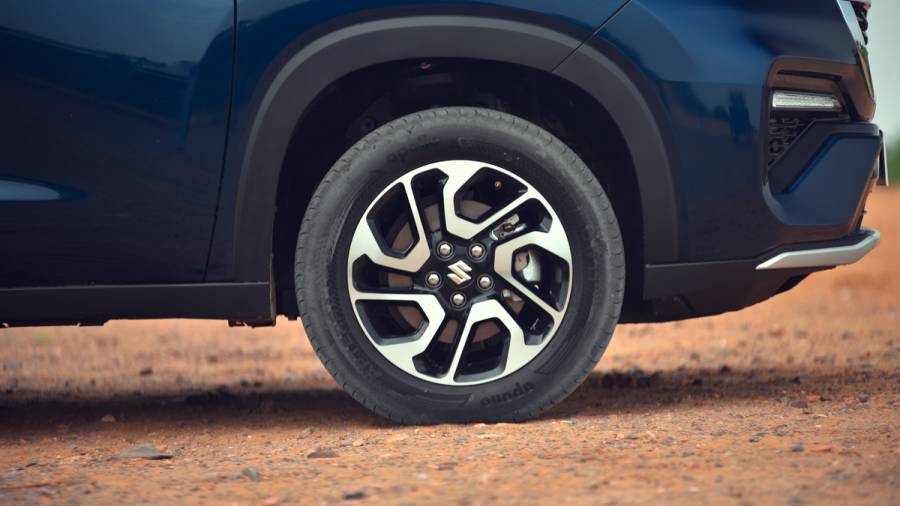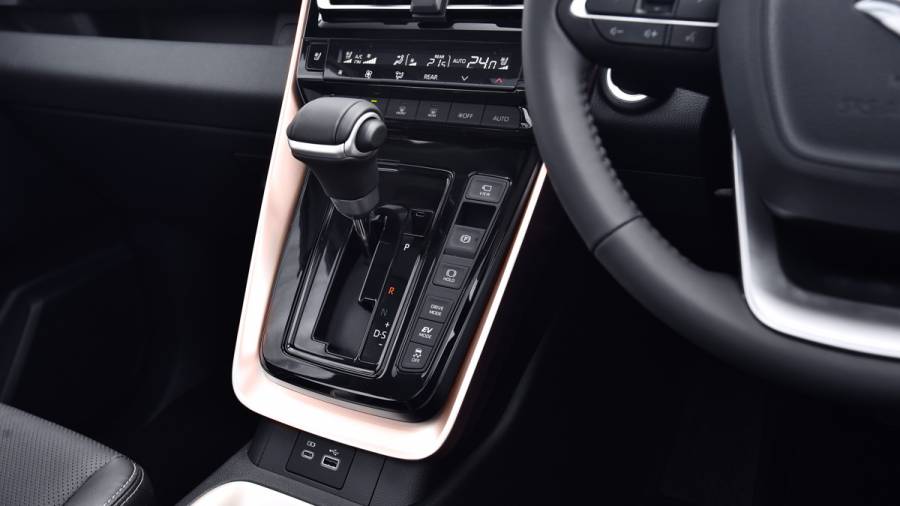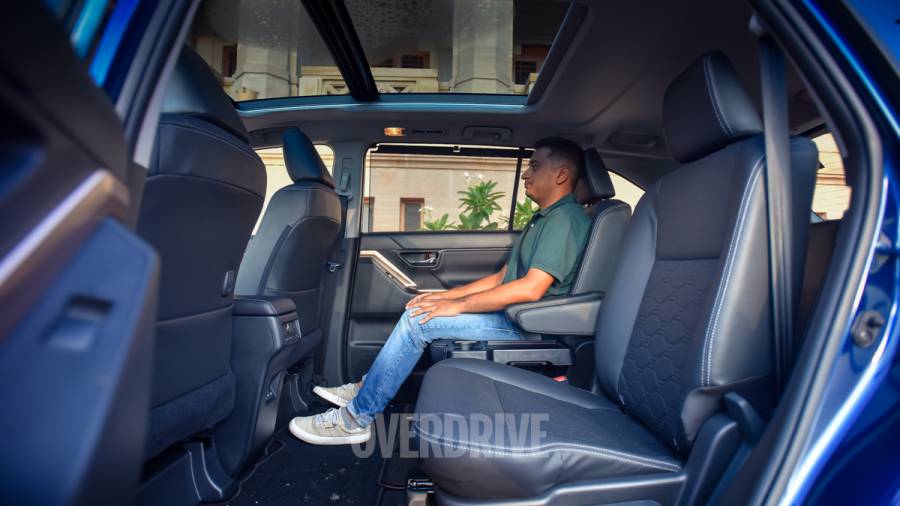Maruti Suzuki Invicto review, first drive - does it stand apart?
There is a general notion that badge-engineering cars isn't a great thing. The lack of many successful examples over the years seems to have solidified this sense. But in recent memory, the Suzuki-Toyota alliance has shown that when done right, it can be the right way to go. Especially in a place as complex as India.

The Maruti Suzuki Invicto is the latest example of this, and possibly the boldest. It's effectively the Toyota Innova Hycross in Maruti finery, making it the most expensive car you can buy from the carmaker currently. So how does the Invicto set itself apart?
Maruti Suzuki Invicto styling, dimensions
The most significant difference to the Maruti Suzuki Invicto comes with how it looks on the outside. Maruti Suzuki has had a strong canvas to work on, the Hycross with its elongated wheelbase, reduced overhangs, its more SUV-like proportions and added flair to the bodywork already had quite a bit of presence going in its favour. The Invicto remains dimensionally identical with its 4,755mm length, 1,845m width and 1,795 mm height but seems to build on this MPV's looks.


Most of this comes from the new Nexa-themed grille. It's larger and has more intricate detailing than the more reserved one in the Toyota. The twin chrome bands that merge into the headlamps will also be good news for those who want to stand out a bit more. The headlamps are the same as the Hycross but get the new three-segment Nexa light signature which is again well-integrated. The same can be said of the new bumpers with the wide LED indicators and the more angular cuts and grooves, although the lack of fog lamps is a disadvantage. The Nexa Blue paint unique to the Invicto is a good complement to the styling too.


A few more things are going on visually to differentiate the two cars in profile and at the rear. The condensed glass house and the haunches around the wheels give the Invicto a good degree of that SUV-like imagery but still retain an MPV's practicality. A notable difference is the 17-inch alloy wheels fitted here. They are a size smaller than the Hycross' and while they carry a flashier design more akin to what you might see on a Baleno or Grand Vitara, there's some sense of proportion lost.

At the rear, the sloping windscreen and spoiler, along with the wide taillamps carry on with the SUV inspiration. The segmented LED motifs have been repeated here although there could have been some contrast to the black cladding on the bumper. It's still functional with a low-load lip for the boot and flat-folding third row.
Maruti Suzuki Invicto interiors, space, features
The interiors of the Maruti Suzuki Invicto will again be familiar if you are acquainted with the Innova Hycross. There's the same sense of quality and functionality to the cabin with the high SUV-like dash with its linear theme and the large 10.1-inch screen. The touchscreen could have had a better resolution, especially when you use the cameras and had more modern graphics, but it gets the job done with Android Auto/Apple Carplay connectivity although a wireless option for Android users would have been more suited at this price point. The semi-digital driver's display is better executed with its detailed information, richer display and easy access.



We also like the thoughtful use of soft materials on the dash and door cards, the hard plastic bits are smooth but most useful is the big bank of switches on the centre console that controls most of the car's functions. They have a damped tactility to them that feels rich. As before, there are useful storage spaces in the doors and around the cabin.

The Invicto is differentiated by its all-black interior theme, which seems to draw some of the richness away from the cabin. A contrasting shade, as in the Hycross, would have uplifted this space. Some of this feeling is retained with the bronze inserts on the doors, vents and centre console along with the silver highlights you see on the dash and steering wheel.

As for seating comfort, it's a bit of a hike up to the front seats but you are met with wide, comfortable chairs and with a good view out. The footwells are large, the steering falls to hand easily and the powered seat adjustment makes finding a driving position easy enough.


But the second and third rows will probably be of more interest to prospective owners of the Invicto, which is where the Maruti again diverges from the Toyota. You have the option of a bench or the two captain seats seen here. The latter can only be manually adjusted and doesn't get the ottomans as in the Hycross. We can skip the powered adjustment, the manual ones here work efficiently enough but the missing ottomans do highlight a touch less underthigh support. Like the front, the cushioning and back support is just right.

The placement of the battery pack under the front seats is still an inconvenience, robbing you of leg space, but the immense sliding range and reclining function of these chairs cover that to an extent. Aside from this, the large windows with the sunshades, the separate climate zone and the panoramic sunroof make for a pleasing space to spend time in.

The third row is again usefully practical, given the TNGA architecture. The captain seats don't tumble which can make getting in a squeeze for larger adults but once inside it's good news. The low floor means you aren't sitting with your knees high up, there's good headroom, the reclining backrest offers good adjustment and there is a reasonable amount of thigh support for a third row. There's enough headroom too so two adults should be quite comfortable here, though the bench isn't wide enough for the three that Maruti Suzuki recommends.
You miss out on branded speakers which isn't too much of a loss but you do get full LED lighting, auto headlamps, an air purifier, cruise control, ambient lighting, dual-zone climate control, a powered tailgate and connected tech. Many of these are the first to be seen on a Maruti car.
Maruti Suzuki Invicto driving impressions, mileage
The Maruti Suzuki Invicto can be had with the hybrid powertrain that uses a 2.0-litre Atkinson cycle petrol motor that puts out 154PS and 190 Nm paired with a 113PS and 206 Nm electric motor, with an e-CVT in the mix for a combined 186PS.

You start in electric power usually but the petrol motor fires up quickly enough once you start picking up speed. The two then work together to move you along, the engine only backing off while coasting or at steady low throttle. This makes for smooth, linear progress as long as you drive the Invicto as it's intended to be, in a calm manner.

This CVT does well enough to meld the two outputs together, especially with the torque from the e-motor filling in here, but there's not quite the immediacy you what when you are looking to make up speed quickly in comparison to a torquey diesel. There is a power mode and paddle shifters that do improve this to a small extent but this is a powertrain best suited to be driven along sedately, where aside from the petrol motor's drone it's an experience most owners will be happy with given the significant efficiency advantages. Maruti Suzuki claims a fuel efficiency of 23.24 kmpl which shouldn't be difficult to get close to as long as you are in conditions where the battery has opportunities to keep charging itself.

This MPV has impressed us with its sense of solidity earlier despite the monocoque architecture, and the 17-inch wheels that you find in the Invicto add to the sense of comfort. The Invicto seems to absorb road imperfections a touch better, with rough patches and small potholes better damped. The suspension can feel a touch agitated while it's doing this and you can notice small body movements at higher speeds, but this settles to a more planted feel when there are occupants in the second and third rows. As you would expect, there is roll around turns but it's well contained with the Invicto leaning quite predictably, although some of the agility of the Hycross has been compromised with the new tyre choice.

Visibility is good with the edges of the bonnet visible and large mirrors while the steering is light and precise without feeling flighty, so the Invicto will be easy to thread through traffic as well. There's s bit of a dead spot in the brake pedal with the regen function but you get used to this soon enough.
Maruti Suzuki Invicto safety
The Invicto misses out on an ADAS option but you get six airbags, TPMS, 360-degree cameras, hill-hold, ISOFIX child seat mounts, an electronic parking brake as well as headrests and three-point seatbelts for all passengers.

Maruti Suzuki Invicto price, verdict
The Maruti Suzuki Invicto seems to have retained all of the attributes that make an Innova so recommendable but with enough to differentiate it from the donor car to not leave it in the Toyota's shadow. The more outward looks and marginally more comfortable ride are good positives. You miss out on the more premium cabin and the elevated second-row experience but you also pay less. Prices for the Invicto start from Rs 24.79 lakh and go up to Rs 28.42 lakh for the version seen here. With the wider reach of Maruti Suzuki's network, this strong MPV package has just become all that more accessible. ?
Images by Anis Shaikh
Also read,
Maruti Suzuki Invicto Vs Toyota Innova Hycross: What's different?
Maruti Suzuki Invicto receives over 6,000 bookings
Maruti Suzuki Invicto launched in India; prices start at Rs 24.79 lakh
Starts Rs 16.26 Lakhs
2755cc
Automatic
150
360
14.29 Kmpl
Related Stories
Top Stories
Latest Videos
Most Popular
- Maruti Suzuki Fronx Drive Feature: Switch to Plan B
- Ford India to make a comeback in 2025? New-Gen Endeavour design patented in India
- Maruti Suzuki Brezza emerges as the most successful SUV of 2023
- Nissan Magnite EZ-Shift review - is the AMT any good?
- Hyundai Creta facelift bookings open for token amount of Rs 25,000













